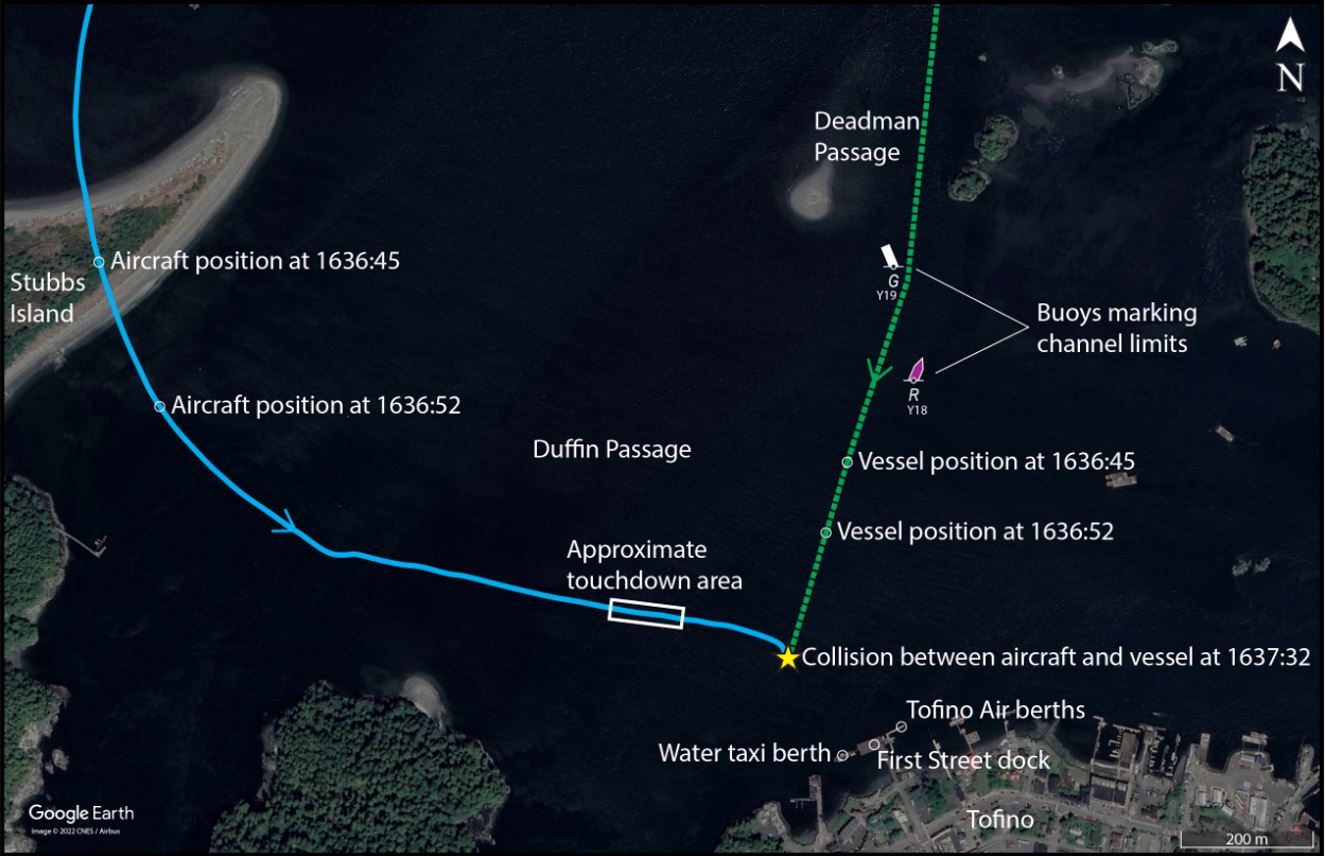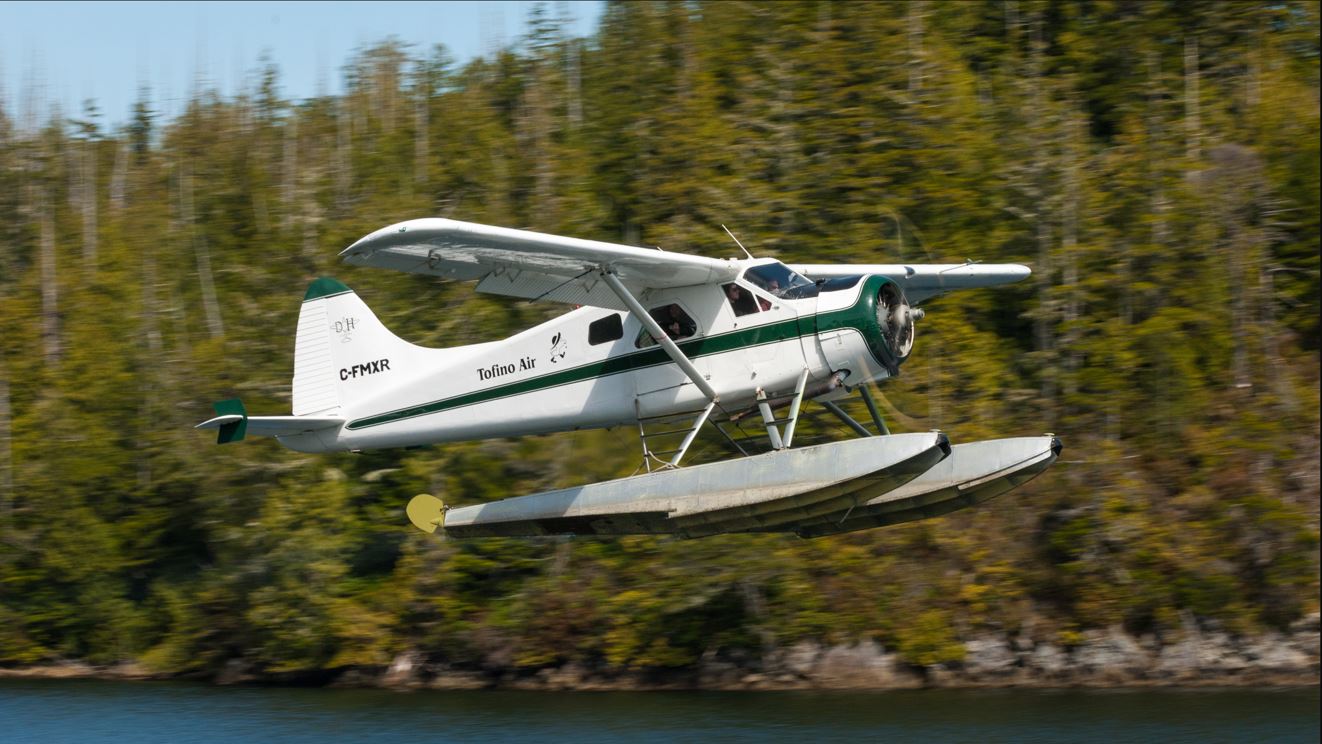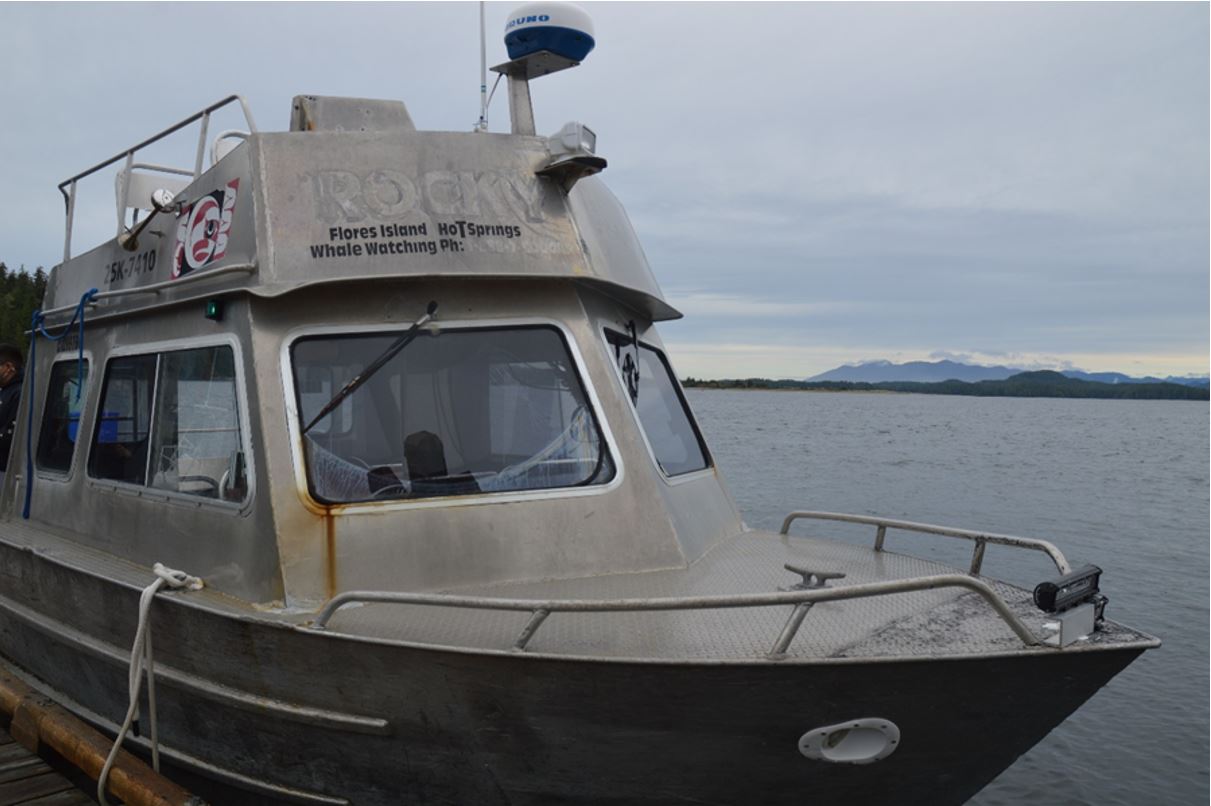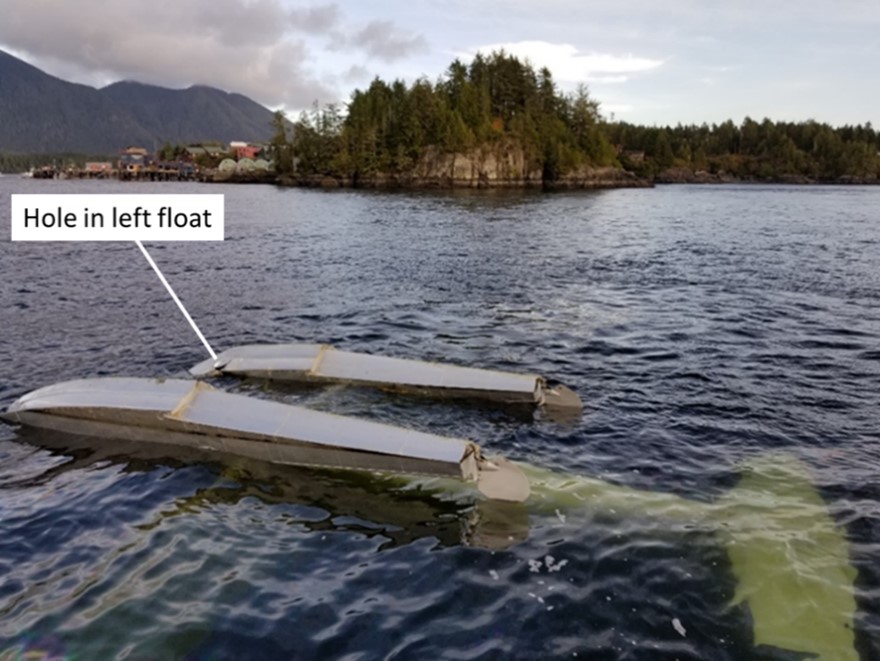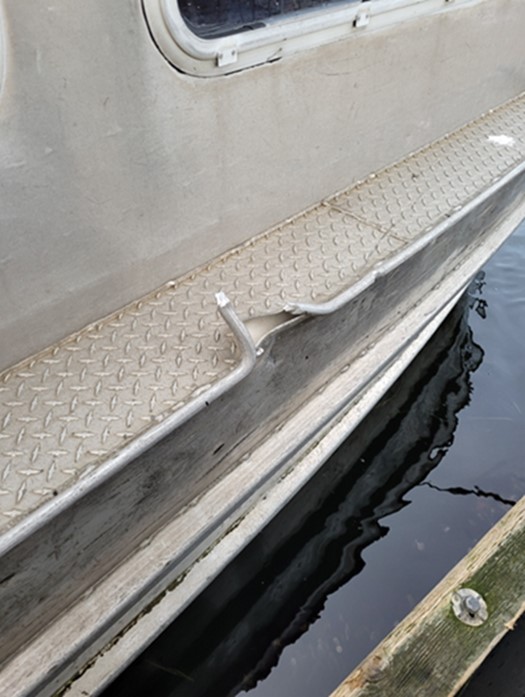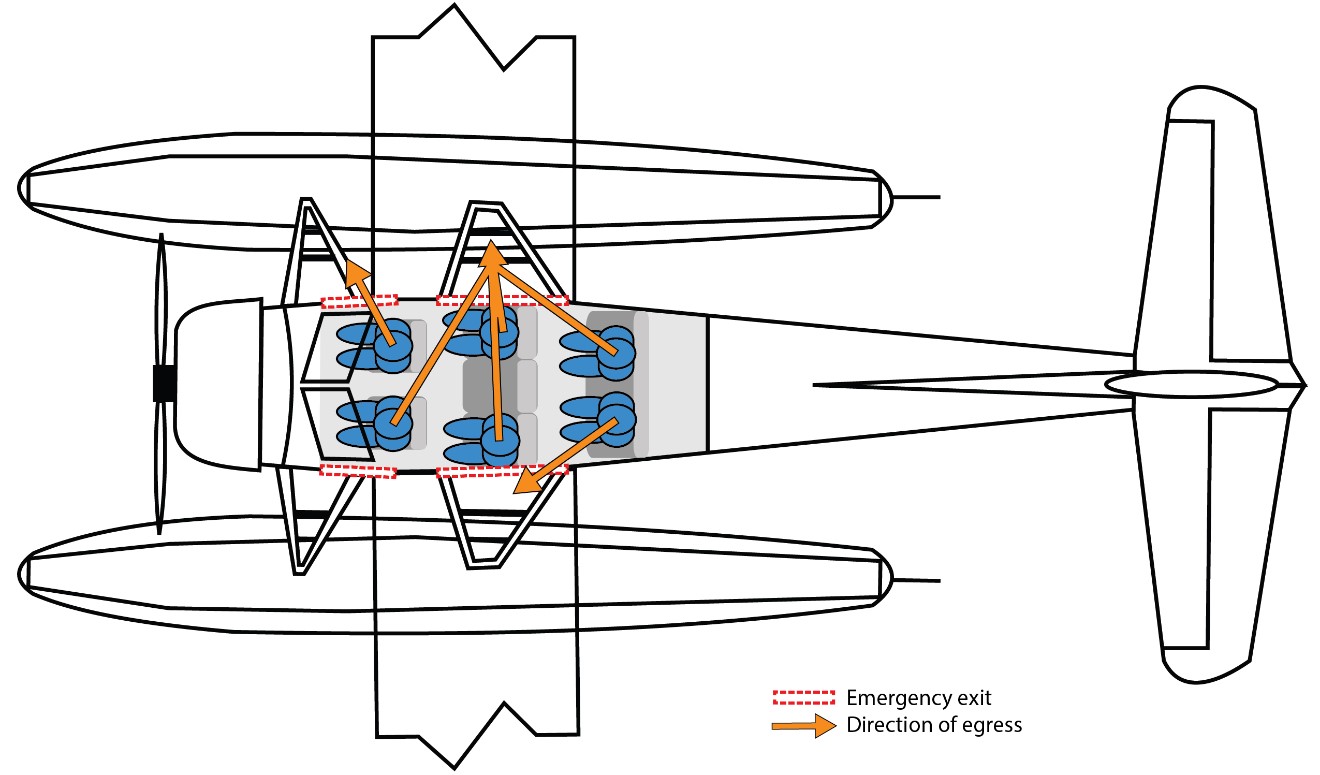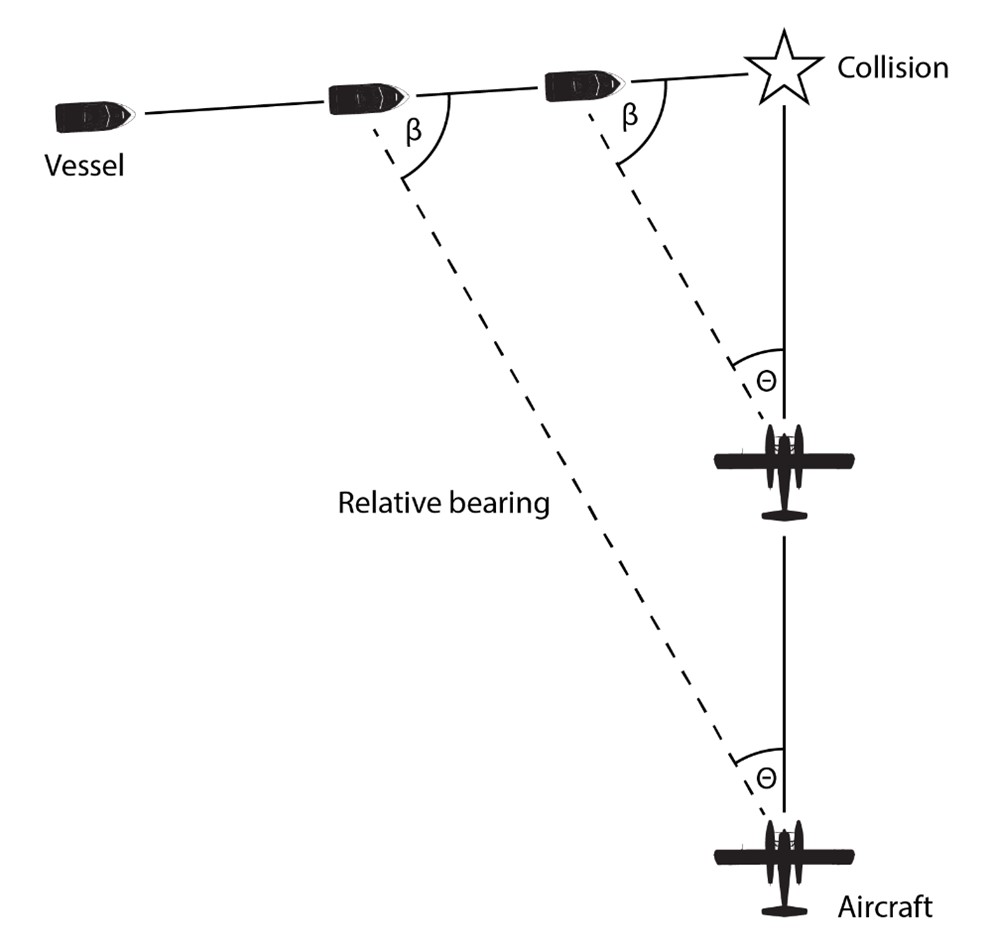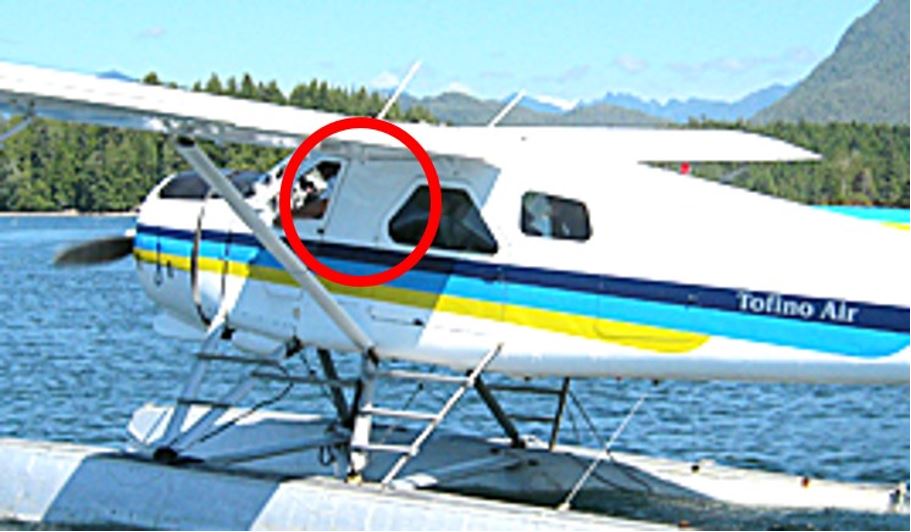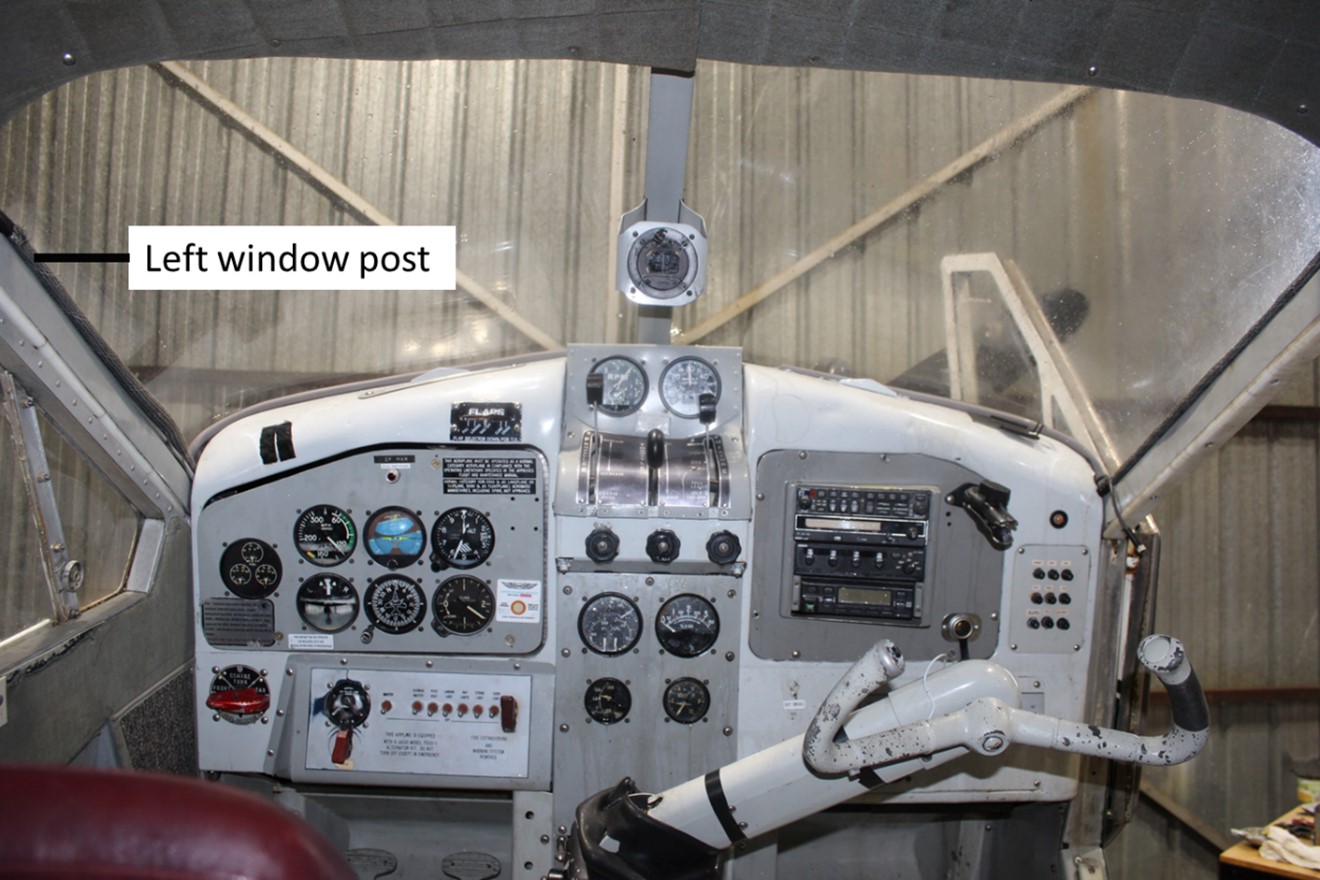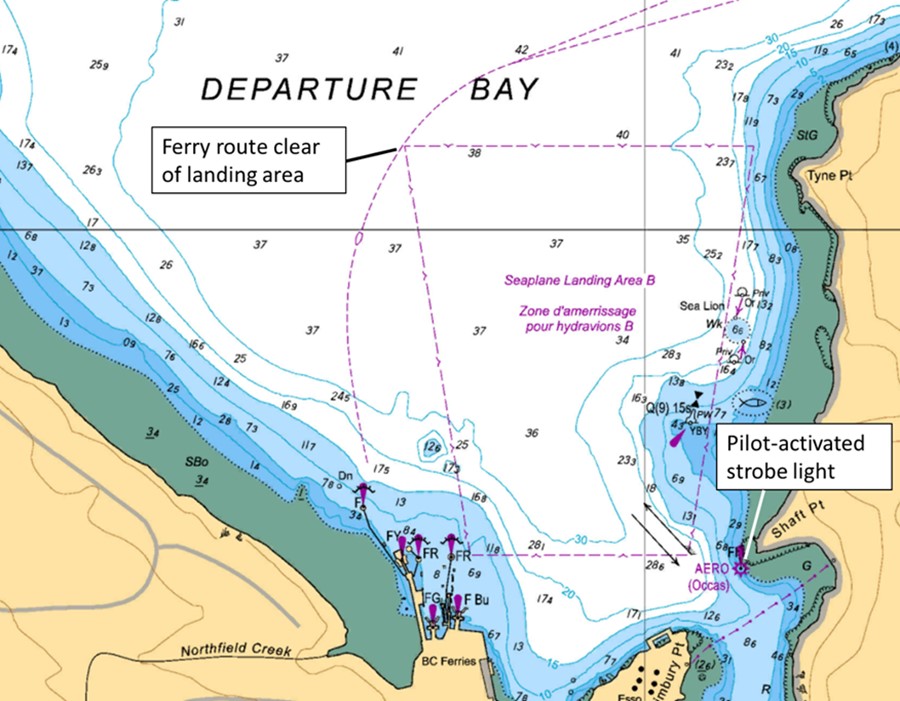Collision between an aircraft and a water taxi
Tofino Air
de Havilland DHC-2 MK. I (Beaver), C-FMXR
and
Eagle Adventures Water Taxi
Water taxi C12997BC (Rocky Pass)
Tofino, British Columbia
The Transportation Safety Board of Canada (TSB) investigated this occurrence for the purpose of advancing transportation safety. It is not the function of the Board to assign fault or determine civil or criminal liability. This report is not created for use in the context of legal, disciplinary or other proceedings. See Ownership and use of content. Masculine pronouns and position titles may be used to signify all genders to comply with the Canadian Transportation Accident Investigation and Safety Board Act (S.C. 1989, c. 3).
Summary
On 18 October 2021 at 1637 Pacific Daylight Time, a float-equipped de Havilland DHC-2 MK. I (Beaver) aircraft operated by Tofino Air and a water taxi known as the Rocky Pass collided in the vicinity of the First Street dock in the Tofino harbour, British Columbia. The aircraft was substantially damaged and, within 2 minutes and 30 seconds of the collision, was inverted with just the floats above the surface of the water. The 5 passengers and pilot on board the aircraft were able to safely egress. Three of the aircraft passengers received minor injuries. The vessel sustained minor damage and 1 passenger on it received minor injuries. The emergency locator transmitter on the aircraft did not transmit a signal. There was no pollution. Footnote 1
1.0 Factual information
1.1 History of the occurrence
1.1.1 The flight
At approximately 1600 Footnote 2 on 18 October 2021, the pilot of the Tofino Air Footnote 3 de Havilland DHC-2 MK. I (Beaver) aircraft (registration C-FMXR, serial number 374) was preparing to depart on a local sightseeing flight from Tofino Harbour Water Aerodrome (CAB4), British Columbia (BC) (Figure 1), with 5 passengers on board. The pilot met with the passengers (4 adults and 1 child) near the aircraft on the First Street dock and gave them a safety briefing. The briefing included the location of the exits on the aircraft and an explanation of how to use their belt-pack inflatable personal flotation devices (PFDs).
At 1607, the aircraft departed on the round-trip flight, which would take approximately 30 minutes. The pilot was seated in the left seat and had his seat set to the full-aft position. This was his 6th round-trip flight of the day from CAB4. He had started work at 0930 and had completed 4 sightseeing flights and 1 charter flight before the occurrence flight.
On return to CAB4 at 1635, the aircraft was on the downwind leg of a left-hand circuit for landing at approximately 250 feet above ground level. The pilot turned on the landing light, set the flaps for landing, made the appropriate arrival radio calls on the aerodrome traffic frequency, and scanned the harbour. He noted that the landing area was clear of any traffic. The aircraft then made a left turn over the northeast point of Stubbs Island and, at 1637:03, turned on short final to land in Duffin Passage in the vicinity of the First Street dock.
On final approach, the 2 passengers seated next to the windows on the left side of the aircraft (middle-left and rear-left seats) observed the water taxi Rocky Pass exiting Deadman Passage and heading toward the First Street dock. Video footage obtained by the investigation shows that the Rocky Pass’s entry into the harbour was noticeable mostly because of its wake.
The aircraft touched down on the water at approximately 1637:26. The distance between the vessel and aircraft was about 80 m. At 1637:29, as the aircraft was decelerating, but still on the step, Footnote 4 the pilot saw the Rocky Pass and, recognizing that a collision was imminent, turned the aircraft to the right to reduce the force of impact. At 1637:32, the aircraft and the Rocky Pass collided.
1.1.2 The voyage
At approximately 1600 that same day, the Rocky Pass departed Ahousaht, BC, for the First Street dock in the Tofino harbour with the operator and 2 passengers on board. This was the vessel operator’s 5th trip of the day. He had started work at 0715 and had completed 3 round trips between Ahousaht and Tofino, and 1 round trip to Hot Springs Cove, BC.
The route between Tofino and Ahousaht is approximately 14 nautical miles (NM) and takes about 34 minutes. Water taxis routinely proceed at speeds of approximately 25 knots while navigating this route, and maintain this speed until they are in the vicinity of the dock.
At around 1636, the Rocky Pass exited Deadman Passage and proceeded toward the First Street dock at a speed of approximately 25 knots (Figure 1). Once at the dock, the plan was to offload the 2 passengers and pick up some more passengers who were waiting to go to Ahousaht. The operator completed a scan of the area as he exited the channel and did not observe any traffic that would impede his intended route.
As the Rocky Pass approached the First Street dock, the operator observed that the berth was occupied by other vessels loading and offloading passengers. He started visually monitoring the vessels at the berth and monitoring the departure announcements of other vessels on the local VHF (very high frequency) radiotelephone channel to plan an approach when space became available.
When the Rocky Pass was about 300 m off the First Street dock, the operator reduced the vessel’s speedFootnote 5 while waiting for the berth to become available. Shortly after, 2 water taxis at the dock made radio calls announcing their intentions to depart, and the operator of the Rocky Pass re-engaged the engines to continue his approach to the dock. At this time, the operator noticed people on the dock waving their arms and trying to warn him of something, which caused him to turn and look behind him through his starboard window. He then saw the aircraft on the water, approximately 15 m away, heading toward the vessel. The operator applied port helm to the vessel in an attempt to avoid a collision. However, within seconds (at 1637:32), the aircraft and the vessel collided in position 49°09.34′ N, 125°54.71′ W. The aircraft’s propeller blades and left float made contact with the vessel’s starboard side.
Video footage taken moments after the collision and obtained by the investigation shows no significant change in the direction of the vessel’s wake before the collision.
1.1.3 Events following the collision
Immediately following the collision, the pilot completed the after-landing checks and shut down the engine. The aircraft’s left float was damaged in the collision and began filling with water. The pilot instructed the passengers to exit the aircraft. Approximately 40 seconds after the collision, as the pilot and passengers began exiting, the aircraft began listing left and pitching forward until it briefly came to rest in a vertical position with the nose in the water and the tail straight up in the air.
The aircraft cabin then began filling with water and the aircraft continued to sink. Approximately 2 minutes and 30 seconds after the collision, the aircraft was inverted, with just the floats above the surface of the water. Once the pilot and passengers egressed, various vessels that had arrived on scene assisted in transporting the passengers to the First Street dock. The Rocky Pass, which had remained on scene, assisted in recovering the pilot from the water and transporting him to shore.
The vessel’s hull remained structurally intact and did not take on any water after the collision. The machinery also remained fully operational.
Three passengers on the aircraft sustained minor injuries while egressing and 1 passenger on the Rocky Pass sustained minor injuries from the impact of the collision. The pilot, vessel operator, and remaining passengers were not injured.
A Canadian Coast Guard rescue craft arrived on scene at 1648 and secured the aircraft to ensure it would not drift with the outgoing current.
Later that evening, the aircraft was pulled through the water by a commercial vessel to a boat ramp where it was removed from the water by a crane. The following day, the aircraft was partially dismantled and moved by truck to the Tofino Air hangar at the Tofino Airport.
1.2 Injuries to persons
1.2.1 Aircraft
The aircraft had 1 pilot and 5 passengers on board. Table 1 outlines the degree of injuries received.
| Degree of injury | Crew | Passengers | Persons not on board the aircraft | Total by injury |
|---|---|---|---|---|
| Fatal | 0 | 0 | – | 0 |
| Serious | 0 | 0 | – | 0 |
| Minor | 0 | 3 | – | 3 |
| Total injured | 0 | 3 | – | 3 |
1.2.2 Vessel
The vessel had 1 operator and 2 passengers on board. Table 2 outlines the degree of injuries received.
| Degree of injury | Crew | Passengers | Persons not on board the vessel | Total by injury |
|---|---|---|---|---|
| Fatal | 0 | 0 | – | 0 |
| Serious | 0 | 0 | – | 0 |
| Minor | 0 | 1 | – | 1 |
| Total injured | 0 | 1 | – | 1 |
1.3 Damage
1.3.1 Aircraft
The aircraft was substantially damaged as a result of the collision.
1.3.2 Vessel
The vessel sustained minor damage as a result of the collision.
1.4 Other damage
Not applicable.
1.5 Personnel information
1.5.1 Aircraft pilot
| Pilot licence | Commercial pilot licence (CPL) |
|---|---|
| Medical expiry date | 01 November 2021 |
| Total flying hours | 2275 |
| Flight hours on type | 1780 |
| Flight hours in the 7 days before the occurrence | 4.4 |
| Flight hours in the 30 days before the occurrence | 31.8 |
| Flight hours in the 90 days before the occurrence | 90.6 |
| Flight hours on type in the 90 days before the occurrence | 88.1 |
| Hours on duty before the occurrence | 7 |
| Hours off duty before the work period | 168 |
The pilot held the appropriate licence and ratings for the flight in accordance with existing regulations. He had completed his annual recurrent ground training on 24 March 2021 and had completed an annual competency check on 02 February 2021 in the DHC-2 aircraft.
He had also completed crew resource management training on 22 February 2021. This training included threat and error management, situational awareness, and pilot decision making. The pilot completed annual emergency procedures training in March 2021, which included donning and inflation of life preservers with practical training.
The pilot had not completed egress training, nor was he required to by regulation at the time of the occurrence.
After the occurrence, on 06 March 2022, new regulations came into effect as a result of TSB Recommendation A13-02.Footnote 6 These regulations require air operators that operate seaplanes under Subpart 703 (Air Taxi Operations) of the Canadian Aviation Regulations (CARs) to provide underwater egress training to their pilots.Footnote 7
1.5.2 Vessel operator
| Certification | Small Vessel Operator Proficiency certificate |
|---|---|
| Medical expiry date | Not required |
| Years of experience operating water taxis | 20 |
| Hours on duty before the occurrence | 9.5 |
| Hours off duty before the work period | 10.5 |
The operator of the Rocky Pass had completed Small Vessel Operator Proficiency training and Vessel Basic Safety (Marine Emergency Duties A3) training in September 2008. At that time, the Small Vessel Operator Proficiency course outline included a minimum of 24 hours of instruction and a 2-hour examination. Three hours of instruction were allocated to safe navigation and collision prevention, which provided participants with a basic understanding of the Collision Regulations.
The operator had been operating water taxis for approximately 20 years, and is the principal operator of the Rocky Pass. The operator did not hold a Marine Medical Certificate, nor was he required to under existing regulations.
1.6 Aircraft and vessel information
1.6.1 Aircraft
The de Havilland DHC-2 MK. I (Beaver) is a single-engine, high-wing, propeller-driven aircraft equipped with EDO 58-4580 floats (Figure 2).
| Manufacturer | de Havilland Aircraft of Canada Ltd.* |
|---|---|
| Type, model and registration | DHC-2 MK. I, C-FMXR |
| Year of manufacture | 1952 |
| Serial number | 374 |
| Certificate of airworthiness | 03 June 1987 |
| Total airframe time | 23 630 hours |
| Engine type (number of engines) | Pratt & Whitney USA, R-985-AN-14B (1) |
| Propeller type (number of propellers) | Hamilton Standard, 2D30-237 (1) |
| Maximum allowable take-off weight | 5090 pounds (2308.79 kg) |
| Recommended fuel type | 80/87 octane minimum grade aviation gasoline |
| Fuel type used | 100 LL |
* Viking Air Ltd. is the current type certificate holder of the de Havilland DHC-2 MK. I (Beaver) aircraft.
The occurrence aircraft underwent a 300-hour inspection on 15 September 2021. At the time of the occurrence, the aircraft had accumulated 42.6 air time hours since that inspection.
The most recent maintenance had taken place on 05 October 2021 and included the installation of an exhaust heater, the replacement of the heater control assembly, and the inspection of a cabin heater.
There was no indication that an aircraft component or system malfunction played a role in this occurrence.
1.6.2 Vessel
| Name of vessel | C12997BC (known as Rocky Pass) |
|---|---|
| Official/licence number | C12997BC |
| Flag | Canada |
| Type | Passenger / water taxi |
| Gross tonnage | 4.6 |
| Length | 7.92 m |
| Draft | 0.61 m |
| Built | 1994 by E & D Manufacturing Ltd., Qualicum Beach, BC |
| Propulsion | Twin 150 hp outboard motors |
| Maximum passenger complement | 12 |
| Operator | Eagle Adventures Water Taxi |
The Rocky Pass (Figure 3) has an aluminum hull and an enclosed cabin that contains the conning station and a passenger seating area. The passenger seating area consists of rows of seats arranged on either side of a centre aisle. The conning station is located on the forward starboard side of the cabin and has a seat for the operator. The conning station has propulsion controls and navigation equipment that includes a radar, a VHF radiotelephone, a magnetic compass, and a GPS (global positioning system).
The cabin has front, side, and rear windows that provide the operator with a generally unobstructed view in the horizontal plane. The deckhead is constructed of aluminum. The 2 outboard engines that propel the vessel are of 150 hp each and were fitted in 2021.
1.7 Meteorological information
The closest aviation weather reporting station was Tofino Airport (CYAZ), located approximately 7 NM from the occurrence site. The most recent aerodrome forecast (TAF) for CYAZ at the time of the occurrence indicated the following:
- winds from 120° true (T) at 10 knots
- visibility more than 6 statute miles (SM)
- few clouds at 2000 feet
The aerodrome routine meteorological report (METAR) issued for CYAZ at 1600 was:
- winds from 150°T at 11 knots
- visibility 15 SM
- few clouds at 3400 feet, broken ceiling at 24 000 feet
- temperature 11 °C
- dewpoint 8 °C
- altimeter 29.98 inches of mercury
There is no wind sock on or near the First Street dock. To determine wind direction and speed, pilots can use flags in the town of Tofino, and observe the waves, trees, and moored boats in the harbour. Additional data collected from a wireless weather station, located on the Canadian Coast Guard dock in the harbour, recorded winds from the southeast at 3 knots.
On the day of the occurrence, the pilot had conducted 6 takeoffs and 5 landings before the occurrence landing and was aware of the weather and wind conditions in and around CAB4.
At the time of the occurrence, the seas were calm and the tide was ebbing. The water temperature was approximately 11 °C.
1.8 Aids to navigation
Not applicable.
1.9 Communications
1.9.1 Aircraft
Floatplanes are equipped with VHF radios that operate on civilian aviation frequencies that range from 118.0 to 136.975 MHz. Pilots in the vicinity of CAB4 typically use the aerodrome traffic frequency (122.15 MHz) to communicate with other aircraft in the area.
1.9.2 Vessels
Vessels are equipped with VHF radios that operate on marine frequencies that range from 156.0 to 162.5 MHz. Vessels in the vicinity of the First Street dock typically use VHF channel 68 (156.425 MHz) to communicate with each other.
1.10 Aerodrome and harbour information
1.10.1 Aerodrome
CAB4 is a registered water aerodrome located approximately 7 NM northwest of CYAZ. A number of air operators and private aircraft use the aerodrome and aircraft traffic increases in the summer months. For example, there were approximately 40 takeoffs and landings per day in July 2019 and 14 takeoffs and landings per day in October 2019.Footnote 8
Tofino Air operates the aerodrome and the First Street dock is the designated water aerodrome dock for aircraft. However, there are also various other private docks in the Tofino harbour that are used by floatplanes.
There are no designated take-off and landing areas in the Tofino harbour; however, floatplanes routinely take off and land in Duffin Passage, near the docks.
1.10.2 Harbour
The Tofino harbour has a number of public and private docks that serve a variety of watercraft, including water taxis, floatplanes, whale watching vessels, tour boats, pleasure craft, and kayaks. The 2 busiest public docks are the First Street dock (also known as the Municipal Wharf) and the Fourth Street dock (also known as the Tofino Small Craft Harbour). The Rocky Pass uses the First Street dock for its water taxi operations.
The Tofino harbour authority manages, operates, and maintains 3 of the public docks, including the Fourth Street dock, which provide accessible facilities to commercial fish harvesters. The Tofino harbour authority is part of the Small Craft Harbours program, which is a nationwide program run by Fisheries and Oceans Canada that is focused on keeping harbours that are critical to the fishing industry open and well maintained. The First Street dock is not managed by the Tofino harbour authority and, therefore, falls under the general responsibility of the District of Tofino.
Water taxis primarily use the west side of the First Street dock and aircraft primarily use the east side. The public docks in Tofino are heavily used, especially in the summer months when the population increases significantly as a result of tourism. Water taxis share berthing space with other vessels at the dock, which means that berthing space is sometimes not available and water taxi operators must time their vessel’s arrival with the departure of another vessel.
Tofino has a permanent population of approximately 2000 peopleFootnote 9 but is a popular tourist destination that receives many visitors in the summer months. In 2018, for example, an estimated 600 000 people visited Tofino, with an estimated peak that year of nearly 70 000 visitors in August. Activities on the water are a major draw for visitors to Tofino.Footnote 10
The Tofino harbour also serves as a critical link for people living in remote communities along the west coast of Vancouver Island, including members of the Tla-o-qui-aht, Ahousaht, and Hesquiaht First Nations. Water taxis and air operators regularly transport residents from these communities into Tofino to buy groceries, get medical treatment, and access the rest of Vancouver Island. They also transport vital service workers (e.g. nurses, teachers, and specialists) to and from these communities.
Following this occurrence, 3 meetings were held in October and November 2021 regarding safety in the Tofino harbour. These meetings were attended by various air and vessel operators, including Tofino Air. Topics discussed included awareness of communication between operators, best safe-practices, and possible ways to improve harbour safety.
1.11 Flight and voyage data recorders
1.11.1 Aircraft
The aircraft was not equipped with a flight data recorder or a cockpit voice recorder, nor was either required by regulation. However, the aircraft was equipped with a Spidertracks satellite flight tracking system for monitoring and flight following purposes. Tofino Air provided the TSB with access to the flight data on the Spidertracks website.
In addition, the TSB was able to extract and use GPS tracking data from an application installed on a mobile device belonging to one of the aircraft passengers.
1.11.2 Vessel
The vessel was not equipped with a voyage data recorder, nor was one required under existing regulations.
1.12 Wreckage and impact information
1.12.1 Aircraft
The aircraft’s propeller and left float were damaged as a result of the collision.
Both propeller blades were twisted and bent and had nicks and gouges on the leading edges. One blade was missing approximately 8 cm of the outboard tip and the other blade had a nick that was 1.2 cm deep and 1.7 cm long on the leading edge located approximately 6.3 cm from the blade tip.
The rear-left float strut was disconnected and there was damage to the rear spreader bar. There was significant damage and wrinkles to the outboard and inboard skins of the left float.
During the collision with the starboard side of the vessel, the left float bent upwards and inwards. Propeller marks on the forward, inboard section of the left float indicate that the float bent upwards enough for the propeller to strike it multiple times and puncture it, leaving a hole that was approximately 8 cm long.
The skin on the bottom of the left float was severely wrinkled, creating a hole on the bottom of the float. This hole allowed water to enter the left float (Figure 4).
1.12.2 Vessel
The starboard side of the Rocky Pass’s hull sustained scrapes and gouges above the waterline as a result of the aircraft’s propeller striking it (Figure 5). The hull remained intact, and the vessel did not take on any water.
The aircraft’s propeller also caught a rubber bumper that was suspended over the vessel’s starboard side by a rope. The rope was attached to the railing atop the cabin. The rope was pulled tight with significant force until it broke. The railing was bent from the force of the propeller pulling on the bumper. The bumper was not recovered.
1.13 Medical and pathological information
There was no indication that the pilot’s or vessel operator’s performance was degraded due to medical factors or fatigue.
1.14 Fire
There was no fire.
1.15 Survival aspects
1.15.1 Aircraft
1.15.1.1 Egress
When the pilot realized there was damage to the front of the left float, he instructed the passengers to exit the aircraft. The aircraft listed left and pitched forward, briefly came to rest in a vertical position (nose-down/tail-up position), and then continued to sink and overturn. From the time of the collision, it took approximately 2 minutes and 30 seconds for the aircraft to be completely inverted.
The occupants all exited the aircraft before it capsized and were transported to the First Street dock by various vessels that had come to provide assistance. The passenger seated in the front-right seat exited through the front-right door. The passenger seated in the rear-left seat exited through the middle-left door. The remaining passengers and the pilot exited through the middle-right door (Figure 6). The passenger seated in the rear-left seat exited onto the left wing and was able to board a vessel without entering the water. All other occupants entered the water after exiting the aircraft and had to swim a short distance to board various vessels. The investigation was unable to determine the exact amount of time each occupant was in the water; however, it was estimated to be up to 2 minutes.
1.15.1.2 Personal flotation devices
Under section 703.83 of the CARs, air operators of seaplanes are required to have procedures in their company operations manual to ensure that crew members and passengers wear a flotation device when a seaplane is operated on or above water. Pilots-in-command of seaplanes are also required to instruct crew members and passengers to wear a flotation device when the seaplane is operated on or above water.Footnote 11 Section 703.83 of the CARs came into effect on 06 June 2021 as a result of TSB Recommendation A11-06.Footnote 12
In this occurrence, the pilot and all of the passengers were wearing belt-pack PFDs, which met the regulatory requirements. This type of PFD is worn in a belt pack around the waist. To inflate the PFD, a person pulls on a tab and then places the inflated PFD over their head and secures it at the neck. Before departure, the pilot had briefed the passengers on how to use the PFDs. One passenger’s PFD was inflated during egress.
This belt-pack PFD is limited to people 16 years of age or older and weighing more than 40 kg. The pilot was unaware of these limitations. There was 1 passenger on the flight who was under 16 years of age and weighed less than 40 kg.
Tofino Air normally uses a different PFD for passengers under 16 years of age weighing more than 16 kg (35 pounds) and less than 40 kg (88 pounds). Tofino Air had this type of PFD available at the base on the day of the occurrence.
1.15.2 Vessel
After the collision, the vessel operator stopped to assess the damage and ascertain the condition of the passengers. The vessel operator then manoeuvred the vessel toward the floatplane and picked up the pilot while other nearby vessels picked up the aircraft passengers. The vessel operator then proceeded to the First Street dock to disembark the pilot and the vessel passengers.
The Rocky Pass carried the following safety equipment: life jackets, PFDs, 6 flares, a life ring, and a fire extinguisher.
1.16 Tests and research
1.16.1 TSB laboratory reports
The TSB completed the following laboratory reports in support of this investigation:
- LP151/2021 – NVM Data Recovery
- LP180/2021 – Video Analysis
1.17 Organizational and management information
1.17.1 Aircraft operator
Tofino Air holds an air operator certificate that allows it to provide scenic and charter flights in accordance with subparts 702 (Aerial Work) and 703 (Air Taxi Operations) of the CARs. Tofino Air does not operate on a fixed schedule.
In the busy season, from May to September, Tofino Air operates 2 DHC-2 and one C180 aircraft. The occurrence took place in the slow season and 1 DHC-2 aircraft was operating in Tofino at the time.
Tofino Air’s Company Operations Manual does not contain formal procedures specific to operating at CAB4, nor is it required to by regulation.
1.17.2 Vessel operator
The Rocky Pass is operated by Eagle Adventures Water Taxi. The vessel is operated primarily as a water taxi to transfer passengers between Ahousaht and Tofino. It is also used to transport passengers to Hot Springs Cove and conduct whale and bear watching tours. The Rocky Pass does not operate on a fixed schedule.
Passenger vessels such as the Rocky Pass, with a gross tonnage of not more than 15 tons and carrying not more than 12 passengers, are defined as “small vessels” and are thus subject to the Small Vessel Regulations. Although such vessels are not required to be inspected or certified by Transport Canada (TC) to operate, they must comply with regulatory requirementsFootnote 13,Footnote 14 at all times.
1.18 Additional information
1.18.1 Mental models
Mental models are internal representations that allow individuals to describe, explain, and predict events or situations in their environment.Footnote 15 The formation of mental models reduces cognitive demands so that attention is freed up to be directed elsewhere. When a mental model is adopted, it generates expectations and is resistant to change. Compelling new information must be absorbed to modify a mental model.
As people make decisions—in part by building a mental model of the world—the limitations of their senses mean that a mental model is never completely accurate. If gaps or conflicts in an individual’s mental model appear, the tendency is for the mind to find ways to make sense of these gaps or conflicts so that they fit within the existing mental model. Sometimes, however, these gaps or conflicts are signs that the mental model is not accurate, and actions based on it may be incorrect given the actual context.
1.18.2 Focused attention
Focused attention is a cognitive state whereby a person’s attention is concentrated on a particular task or concept for a period of time. In operational settings, focused attention enables operators to actively seek out specific types of information in support of a task. When an operator is required to perform simultaneous tasks that each require the same level of attention, overall performance diminishes. For example, performing a visual task, such as monitoring traffic at a berth and detecting when the berth becomes vacant for docking, increases demands on visual attention and reduces the available capacity for other visual tasks, such as scanning for other nearby traffic. Research has shown that stimuli in the peripheral vision are harder to detect when the focus of attention is on a central task.Footnote 16
1.18.3 Visual detection of movement
The perception of objects moving toward a viewer is affected by the physiological differences in foveal and peripheral vision. People are sensitive to motion in their peripheral vision; however, this sensitivity diminishes when objects are stationary in the visual field. If a target is converging on the same point as the viewer, relative bearing will remain constant and it is likely that the target will not be noticed because its position on the retina appears stationary (Figure 7). Also, although both the foveal and peripheral vision systems can detect movement, the foveal system is better at detecting slow movement, while the peripheral system is better at detecting rapid movement.Footnote 17
1.18.4 Contrast
The amount of contrast between an object on the water and its background can affect the ability of a pilot to detect the object, with objects that have minimal contrast with their background being harder to detect. Also, backgrounds that include ground features can interact with the shape of the object and reduce the distinctiveness of the object.Footnote 18
1.18.5 Aircraft structure and windscreen configuration
The DHC-2 fuselage has a structure between the 2 forward-most windows on the left side (Figure 8). Pilots who have their seats set to the full-aft position, as was the case in this occurrence, sit beside this structure, which can limit the view to the left of the aircraft.
Aircraft windscreen configurations can also limit a pilot’s field of view and interfere with the pilot’s ability to detect objects (Figure 9). As part of the analysis done by the TSB laboratory, it was determined that during the short-final and touch-down phase, the vessel would likely have been visible to the pilot in the bottom of the left windscreen for approximately 25 seconds as it moved from behind the left window post to the middle of the left windscreen. The vessel would have appeared to remain stationary in the middle of the left windscreen for 12 seconds, until the collision occurred.
1.18.6 Vessel visual limitations
In addition to routine vessel traffic, floatplanes are another hazard that can be encountered on the water while transiting the Tofino harbour. Floatplanes that are in the take-off and landing phases, either on the water or in the air, operate at higher speeds than other marine traffic and are in the harbour area for a relatively short time. For vessels that have solid deckheads, like the Rocky Pass, the operator’s field of view is limited by the deckhead, which can make visual detection of the relatively faster moving aircraft difficult. Cabin designs that incorporate solid deckheads are typical of water taxis operating in the area.
When the operator on the Rocky Pass was seated at the conning position, the vertical range of his field of view from the horizontal plane upwards was approximately 35°. Beyond this point, his field of view was obscured by the deckhead. When the Rocky Pass exited Deadman Passage, the aircraft was within the operator’s field of view, but was in his peripheral vision. The aircraft was not obscured by the deckhead.
The sailing directionsFootnote 19 note that, for the Pacific Coast, “[i]n recent years the number of marine traffic incidents between vessels and seaplanes has increased.”Footnote 20 The sailing directions advise vessel operators to “avoid areas where seaplanes are known to operate, particularly in conditions of poor visibility.”Footnote 21
1.18.7 Collision avoidance in harbours shared by air and marine operators
There are a number of harbours in BC shared by vessel and aircraft operators, including those in Vancouver, Victoria, Nanaimo, and Campbell River. These harbours use various strategies to mitigate the risk of collisions between aircraft and vessels, such as designated landing areas, pilot-activated lights, and vessel speed limits.
1.18.7.1 Designated landing areas
Designated floatplane landing areas can help keep aircraft operating zones free by allowing vessel operators to plan routes that are clear of these areas. The boundaries of these designated landing areas are often indicated by buoys, so that they are clearly visible to vessel operators. Vessel operators who are required to pass near a landing area can mitigate the risk of conflict by specifically looking out for any approaching aircraft.
Designated landing area information is available to vessel operators on nautical charts and sailing directions. As an example, Figure 10 shows the nautical chart for Nanaimo harbour, which has both a designated landing area and a pilot-activated light. There is no designated landing area for floatplanes in Tofino.
1.18.7.2 Pilot-activated light
Visual aids, such as flashing aeronautical lights that are activated by the pilotFootnote 22 of a floatplane, are one way pilots can broadcast their intentions to vessel operators in the area. The Tofino harbour was not equipped with pilot-activated lighting.
1.18.7.3 Vessel speed limits
Vessel speed limits can help ensure that marine traffic is proceeding at speeds that allow sufficient time for the vessel operator to take effective action to avoid hazards. In some BC harbours, speed is guided by imposed speed limits.Footnote 23 In others, speed is left to the discretion of the individual operators. To determine a safe speed, the operator assesses the risk of various factors, such as the geography of the area, weather conditions, visibility, vessel characteristics, nearby traffic, proximity to shore, experience level of the crew, potential for wake damage, and debris floating in the water.
In Canada, local authoritiesFootnote 24 can ask TC to implement restrictions under the Vessel Operation Restriction Regulations (VORR). TC has published a guide entitled Local Authorities’ Guide: Vessel Operation Restriction RegulationsFootnote 25 to help local authorities make a formal submission under the above regulations.
There are currently 61 speed restrictions in force at locations in BC.Footnote 26 Some examples of the speed limits and the reasons for their implementation are listed in Table 7.
| Location | Speed limit | Rationale |
|---|---|---|
| Hardy Bay (inner harbour), Port Hardy, BC | 5 km/h | Concern for safety because the harbour was becoming busier and concern that large wakes created by fast vessels could damage other vessels. |
| Tsehum Harbour, North Saanich, BC | 8 km/h | Multiple reports of near-misses in and around the harbour and damage to vessels that were refuelling caused by large wakes created by vessels going too fast. |
| Ganges Harbour, Saltspring Island, BC | 10 km/h | Erosion at the high-water line, property damage, and damage to docks due to vessels entering and leaving the harbour too quickly. |
There were no such limits applicable to vessels in the Tofino harbour, and the District of Tofino was not aware of the VORR or the guide at the time of the occurrence.
1.18.7.4 Collision avoidance and safe speed
In Canada, the Collision Regulations set out rules to help prevent collisions in waterways. The rules apply to vessels and to floatplanes when the floatplane is operating on the water. In accordance with the rules, floatplanes on the water are required, in general, to “keep well clear of all vessels and avoid impeding their navigation.”Footnote 27 In circumstances where a risk of collision exists, the Collision Regulations state that whichever craft (vessel or floatplane) has the other on its own starboard side shall keep out of the way and avoid crossing ahead of the other.Footnote 28
The rules also require vessels to be operated at a safe speed at all times so that proper and effective action can be taken to avoid collisions and so that vessels can be stopped within a distance appropriate to the prevailing circumstances and conditions.Footnote 29
Operators of passenger vessels with a gross tonnage of not more than 15 tons, such as the Rocky Pass, are required to hold a Small Vessel Operator Proficiency certificate, which provides 3 hours of training on collision prevention.
1.18.8 Previous occurrence
On 17 August 2020, a float-equipped Cessna 208B aircraft was conducting a flight from Vancouver Harbour to the Tofino harbour with 1 pilot and 9 passengers on board.Footnote 30 While the aircraft was landing, a water taxi passed in front of it, requiring the aircraft to use full reverse thrust to avoid a collision. Neither the pilot nor the vessel operator was aware of the other until they were in the immediate vicinity of one another.
1.18.9 Water Ceremony
In November 2021, local First Nations communities held a Water Ceremony on the Tofino First Street dock and in the Tofino harbour intended to cleanse the water, pilots, vessel operator, passengers, aircraft, and boats that were affected by 2 aircraft accidents,Footnote 31 including this one, that occurred in the Tofino harbour in 2021 and to bring the community together to heal and move forward.
2.0 Analysis
2.1 General
There was no indication that a component or system malfunction played a role in this occurrence for either the aircraft or the vessel.
The analysis will focus on factors that affected the visual perceptions of the aircraft pilot and vessel operator, local issues relating to safety in the harbour, and the use of personal flotation devices (PFDs) on the aircraft.
2.2 Factors affecting visual perception
2.2.1 Aircraft
Upon arrival at Tofino Harbour Water Aerodrome (CAB4), British Columbia (BC), the pilot had an unobstructed view of the harbour and, while the aircraft was on the downwind leg of the left-hand circuit, the intended landing area was seen to be free of any traffic and obstacles. Nothing out of the ordinary was observed that warranted special measures to track inbound traffic on the water to the landing area, and the pilot continued normal scans while in the left-hand circuit for landing.
The aluminum hull of the Rocky Pass, when viewed from the air, was a similar colour to the surrounding grey waters in the harbour, meaning that it was a target with minimal contrast in relation to its immediate background. Investigative data suggests that when the aircraft was manoeuvring for landing at the Tofino harbour, the Rocky Pass’s entry into the harbour was noticeable mostly because of its wake, which was white and therefore had greater contrast with the surrounding grey waters. However, other features such as white structures and rocks on and around the shoreline likely made the wake less distinct.
When the aircraft was in the left-hand circuit manoeuvring for landing, its lowered wing, while turning in the circuit, obscured any traffic on the water that was perpendicular to the left side of the aircraft. As well, the fuselage has a structure between the 2 forward-most windows on the left side; pilots who adjust their seat settings furthest aft, as was the case in this occurrence, sit beside this structure, which interferes with their ability to see objects on the left side of the aircraft unless they lean forward to do visual scans. At the time the aircraft began the turn from the base leg onto final, the Rocky Pass had just exited Deadman Passage and its trajectory was perpendicular to the left side of the aircraft.
Finding as to causes and contributing factors
The aircraft’s lowered wing during the base-to-final turn coupled with the pilot’s seating position interfered with the pilot’s view out the left-side window, and the Rocky Pass’s entry into the harbour, which was unexpected in an otherwise clear area, went undetected.
The pilot’s focus of attention on final approach is normally outside to scan for traffic and obstacles in the landing area, with the occasional glance inside for instrument checks (e.g., airspeed, altitude). However, in the moments just before touchdown, a pilot’s focus is typically centred on the horizon to judge the aircraft’s attitude and height above the water. This centralized focus of attention is not unusual, but it means that the range of visual scans is narrowed.
Once the aircraft was on final approach, the Rocky Pass would have appeared in the aircraft’s left windscreen from the pilot’s perspective as the vessel headed to the First Street dock. In the 25 seconds from when it would have first been visible in the bottom of the left windscreen, moving from behind the left window post to the middle of the left windscreen, the movement of the vessel in the windscreen would have been slow enough to be unremarkable. Peripheral vision is better at detecting rapid movement than slow movement.
In the 12 seconds before impact, the position of the vessel in the windscreen would have appeared stationary because when 2 objects are moving toward the same point at the same time, the relative bearing for each will remain constant. Since human vision is better at detecting movement than targets that are stationary, the vessel went undetected. It is also likely that, at some points as the aircraft was on short final and during the touch-down phase, the pilot’s ability to see the vessel was reduced because his view was obstructed by the aircraft’s nose and left window post.
Finding as to causes and contributing factors
During the touch-down phase, the pilot’s attention, which was primarily focused straight ahead, combined with the little or no relative movement of the vessel in the left windscreen and the obstructions caused by the aircraft’s nose and left window post, reduced the likelihood of detection of the vessel.
2.2.2 Vessel
When the vessel entered the harbour through Deadman Passage, the vessel operator completed a scan of the harbour and did not observe any traffic that would impede his intended route to the First Street dock. At this time, the aircraft was in the operator’s peripheral vision and the Rocky Pass was operating at a speed of around 25 knots. This speed is consistent with the speed that most other water taxis operate within the Tofino harbour. However, speeds in this range have implications for the perception of visual information that is critical to an operator’s awareness of other traffic.
For operators of water taxis like the Rocky Pass, establishing an accurate mental model of aircraft and other vessels in the Tofino harbour is largely based on sight. Travelling at faster speeds reduces the time available for operators to detect objects around them, especially when the object is in their peripheral vision. At faster speeds, operators also have less time to identify the trajectory of a moving object in relation to their own vessel. Vessel operators may also encounter situations where the relative bearing of a converging object remains constant, making it harder to detect because it appears stationary.
Finding as to causes and contributing factors
The speed at which the vessel was travelling and the relatively stationary position of the aircraft in the operator’s peripheral vision likely contributed to the operator not detecting the aircraft when the Rocky Pass was exiting Deadman Passage.
For the vessel operator, approaching the First Street dock was a task-intensive phase of the voyage that required him to divide his attention between navigational duties and visually monitoring the incoming and outgoing vessel traffic at the dock to establish an available berth. Once the vessel operator had scanned the harbour and established a mental model of his intended route as being clear, his visual attention was primarily focused forward, toward the berth, to accomplish the multiple tasks required of him.
Finding as to causes and contributing factors
After exiting Deadman Passage, the vessel operator’s visual attention was primarily focused forward, toward the berth, reducing the likelihood of detecting the aircraft’s approach on the vessel’s starboard side.
2.2.3 The collision
The aircraft touched down on the water about 80 m from the Rocky Pass. Three seconds after touching down, the pilot saw the Rocky Pass and veered to the right to reduce the force of impact. The vessel operator saw the aircraft at approximately the same time, having been alerted by people waving at him on the dock. The operator applied port helm to the vessel in an attempt to avoid a collision but, given the distance between the aircraft and the vessel, a collision was unavoidable.
Finding as to causes and contributing factors
The aircraft pilot’s and the vessel operator’s visual perception was affected by several factors and neither recognized that their routes would conflict until it was too late for evasive action to be effective. As a result, the aircraft and vessel collided, causing significant damage to the aircraft that required the occupants to conduct an emergency egress.
2.3 Harbour safety
In the Tofino harbour, floatplanes conduct a large number of takeoffs and landings in proximity to public docks that are heavily used by water taxis, pleasure craft, and other vessels. When getting underway, vessels can quickly reach speeds of around 25 knots and can move from a position of being secured at the dock to impeding an aircraft’s landing path in less than a minute. Aircraft also take off and land at various locations in the harbour due to wind, traffic, and noise considerations, so there is no predictability with respect to where they will be operating at a given moment. As well, neither aircraft nor water taxis in the harbour operate on a fixed schedule, so there is no predictability with respect to the timing of their departures and arrivals, and the dynamics in the harbour can change rapidly.
Visually identifying an approaching target is currently the only means available for floatplane pilots and vessel operators in the Tofino harbour to mitigate the risk of collision. However, factors such as sun glare, contrast with the background, size and colour of the vessel or aircraft, as well as sightlines from the aircraft and vessel, can obstruct the view of pilots and vessel operators and limit their ability to identify collision risks. The task can get even harder when operating in conditions of restricted visibility. As well, because aircraft and vessels operate on different VHF (very high frequency) radio frequencies, they cannot maintain a listening watch to know each other’s intentions.
Finding: Other
Floatplanes and vessels operate on different VHF radio frequencies; therefore, pilots and vessel operators are not aware of any communications that the other may transmit, such as arrival or departure intentions, traffic-related communications or warnings, or collision avoidance information.
The Tofino harbour has no harbour speed limits, which means that vessels can operate at high speeds, increasing the risk of collisions. Slower speeds provide operators additional time to fully assess and avoid close-quarters situations. To mitigate the risk of collisions, some BC harbours have implemented speed restrictions in accordance with Transport Canada’s (TC’s) Vessel Operation Restriction Regulations (VORR). TC’s procedure for implementing speed restrictions in harbours relies on local authorities recognizing that a risk exists in their harbours, proactively seeking out the procedure for how to implement a restriction, and submitting an application to request a restriction to TC. However, because local authorities for different harbours have varying degrees of maritime knowledge and differing mandates, they may not have either the experience necessary to identify the level of risk in their harbours or the mandate to do so. In Tofino, it was not clear who could act as the local authority, and TC does not proactively reach out to local authorities to inform them of the VORR and their ability to implement speed restrictions. The District of Tofino was unaware of the VORR and the procedure for implementing speed restrictions.
Finding as to risk
If TC’s process for implementing safe speeds in harbours relies solely on local authorities recognizing that a risk exists and proactively initiating the process for implementing a restriction, there is a risk that restrictions will not be implemented and vessels will continue to operate at speeds that pose a risk of collision.
Finally, some BC harbours that are shared by air and marine traffic have designated landing and take-off areas for floatplanes and/or flashing aeronautical lights that can be activated by the floatplane pilot when intending to land or take off. Pilot-activated lights let floatplane pilots warn vessel operators of their presence. Designated landing areas let vessel operators know where they can expect floatplanes to be taking off or landing, which allows them to take routes that avoid an encounter with a floatplane. However, none of these defences had been implemented in the Tofino harbour, and pilots and vessel operators relied solely on visual identification of other traffic in the area to mitigate the risk of collisions.
Finding as to risk
If busy harbours that accommodate both vessel and aircraft traffic do not have designated aircraft landing areas, means for aircraft to signal their presence, or vessel speed limits, there is an increased risk of collision as a result of vessels and aircraft operating in close proximity at high speeds.
2.4 Personal flotation devices
In this occurrence, the pilot and all of the passengers were wearing belt-pack PFDs, which met regulatory requirements. However, these PFDs are designed for people over 16 years of age weighing more than 40 kg.
One of the passengers on the flight was younger and weighed less than these specifications; therefore, the PFD was improperly sized for that passenger. A properly sized PFD is an important factor in survivability.
Finding as to risk
If aircraft passengers wear PFDs that are not properly sized, there is a risk that the device will not function as intended, which could result in injury or death.
3.0 Findings
3.1 Findings as to causes and contributing factors
These are conditions, acts or safety deficiencies that were found to have caused or contributed to this occurrence.
- The aircraft’s lowered wing during the base-to-final turn coupled with the pilot’s seating position interfered with the pilot’s view out the left-side window, and the Rocky Pass’s entry into the harbour, which was unexpected in an otherwise clear area, went undetected.
- During the touch-down phase, the pilot’s attention, which was primarily focused straight ahead, combined with the little or no relative movement of the vessel in the left windscreen and the obstructions caused by the aircraft’s nose and left window post, reduced the likelihood of detection of the vessel.
- The speed at which the vessel was travelling and the relatively stationary position of the aircraft in the operator’s peripheral vision likely contributed to the operator not detecting the aircraft when the Rocky Pass was exiting Deadman Passage.
- After exiting Deadman Passage, the vessel operator’s visual attention was primarily focused forward, toward the berth, reducing the likelihood of detecting the aircraft’s approach on the vessel’s starboard side.
- The aircraft pilot’s and the vessel operator’s visual perception was affected by several factors and neither recognized that their routes would conflict until it was too late for evasive action to be effective. As a result, the aircraft and vessel collided, causing significant damage to the aircraft that required the occupants to conduct an emergency egress.
3.2 Findings as to risk
These are conditions, unsafe acts or safety deficiencies that were found not to be a factor in this occurrence but could have adverse consequences in future occurrences.
- If Transport Canada’s process for implementing safe speeds in harbours relies solely on local authorities recognizing that a risk exists and proactively initiating the process for implementing a restriction, there is a risk that restrictions will not be implemented and vessels will continue to operate at speeds that pose a risk of collision.
- If busy harbours that accommodate both vessel and aircraft traffic do not have designated aircraft landing areas, means for aircraft to signal their presence, or vessel speed limits, there is an increased risk of collision as a result of vessels and aircraft operating in close proximity at high speeds.
- If aircraft passengers wear personal flotation devices that are not properly sized, there is a risk that the device will not function as intended, which could result in injury or death.
3.3 Other findings
These items could enhance safety, resolve an issue of controversy, or provide a data point for future safety studies.
- Floatplanes and vessels operate on different VHF (very high frequency) radio frequencies; therefore, pilots and vessel operators are not aware of any communications that the other may transmit, such as arrival or departure intentions, traffic-related communications or warnings, or collision avoidance information.
4.0 Safety action
4.1 Safety action taken
4.1.1 Transportation Safety Board of Canada
On 08 February 2022, the TSB issued Marine Safety Information Letter MSI 01/22 advising Transport Canada that there are no speed limits for vessels in the Tofino harbour and that the local authorities in Tofino were unaware of the Vessel Operation Restriction Regulations (VORR).Transport Canada responded to the TSB by reiterating that the local authority has the responsibility to apply for vessel operations restrictions. Transport Canada does not plan to take further action to raise awareness about the VORR.
4.1.2 Tofino Air
On 04 November 2021, the pilot completed additional training on emergency procedures, including the different types of personal flotation devices and their limitations.
Since the accident, flight training at Tofino Air has included more complete scanning techniques (moving torso to scan, scanning to pick up on any stationary object illusions, and addressing blind spots) and a “landing scan” check box was added to Tofino Air’s flight training form.
4.1.3 Transport Canada
On 26 April 2022, Transport Canada reached out to the Nuu-chah-nulth Tribal Council regarding occurrences in and near the Tofino harbour in 2021 and early 2022. Transport Canada offered a follow-up discussion to share information about the current regulatory regime and better understand the Council’s perspectives about transportation safety in the Tofino area.
This report concludes the Transportation Safety Board of Canada’s investigation into this occurrence. The Board authorized the release of this report on 22 February 2023. It was officially released on 30 March 2023.
